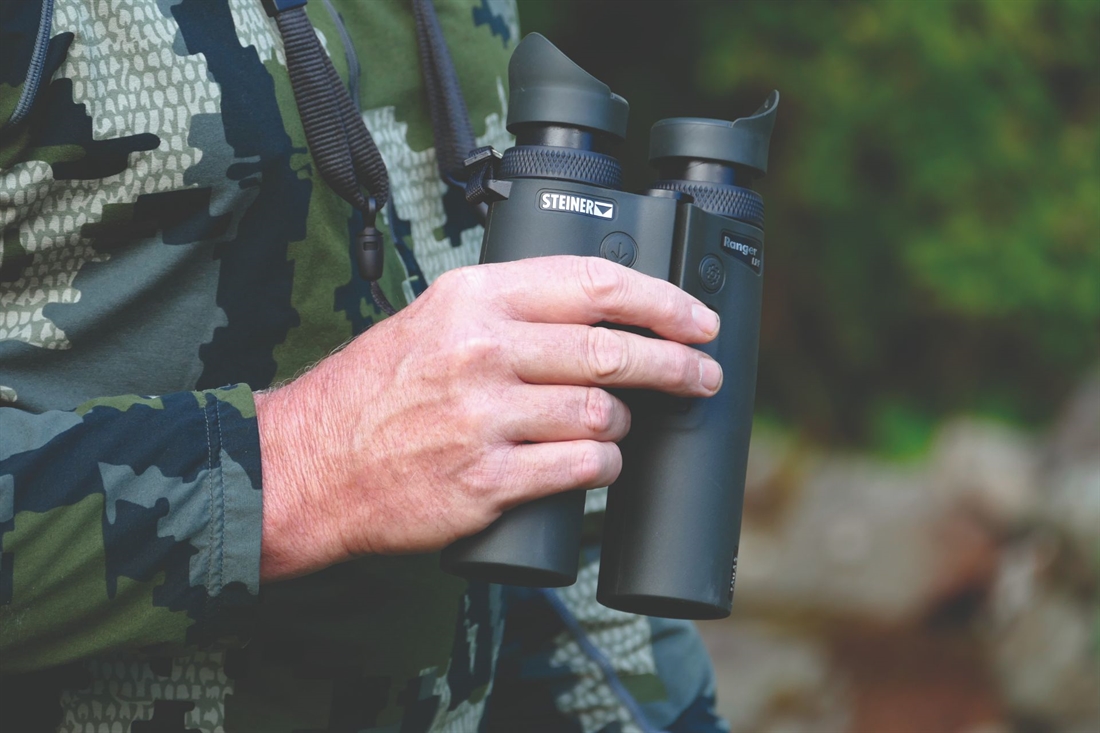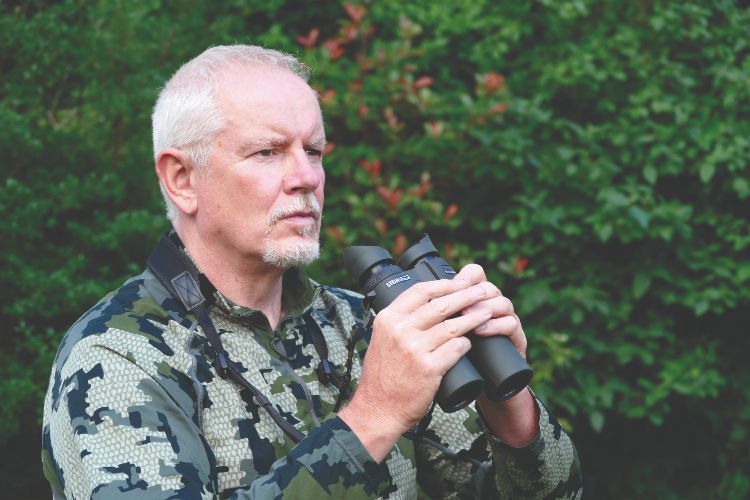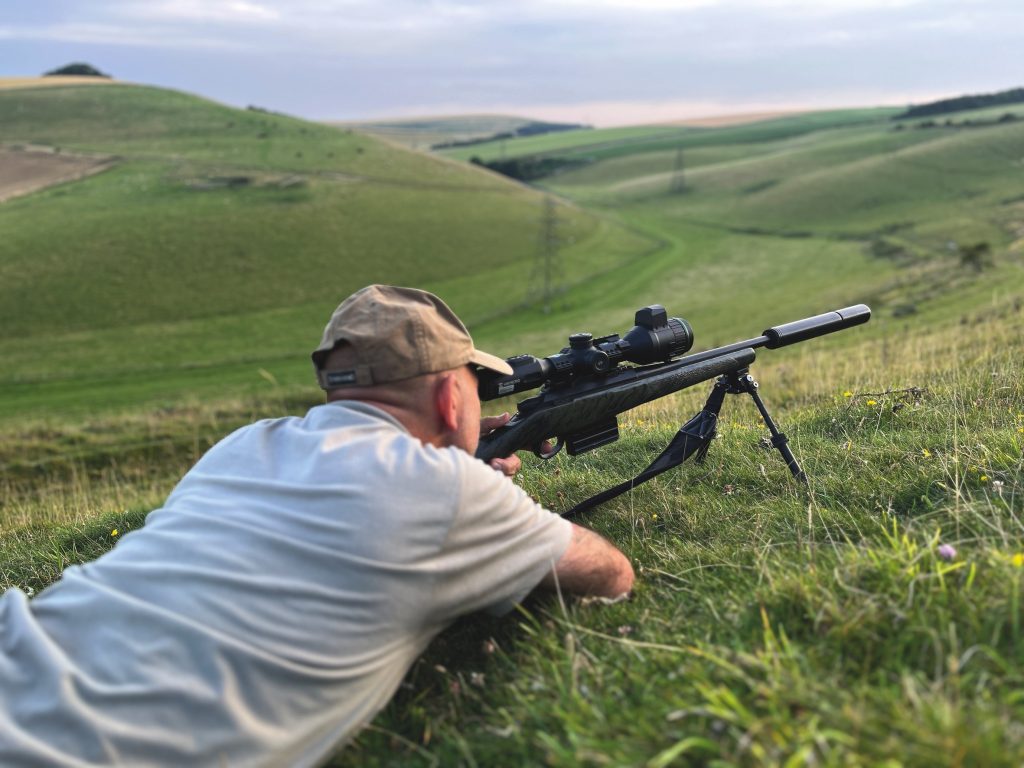Kit test: Steiner Ranger LRF binoculars
Quality, ultra-tough LRF binoculars at a sensible price. Paul Austin looks at (and indeed through) the very latest optical offering from Steiner in this review of the Steiner Ranger LRFs!

Regular readers might recall our review of the Steiner Ranger 8 scope in the last issue. Well, this month their partner-in-crime has arrived – the all-new Ranger LRFs. I was lucky enough to be invited to the launch event at a stunning castle in northern Germany recently, where both products were unveiled to the world amid a ton of fanfare. Now it’s finally time to see if the LRFs live up to the Ranger name.
A 300m range gave the scope a chance to stretch its legs a little, but that’s a fairly limiting distance for a pair of LRF binoculars, so I was curious to see how they performed in the Welsh hills. I am pleased to report that the Ranger LRFs arrived in my sticky mitts a week or two later and the serious testing could start as I glass the hills and valleys of my adopted home in the Welsh mountains. Before delving into the specs, let’s deal with first impressions and look and feel.
 Steiner Ranger LRF ergonomics
Steiner Ranger LRF ergonomics
The Ranger LRFs are a roof prism design, which is one reason for their elegant lines. Without close inspection it’s really quite hard to tell they are actually LRF binos at all. LRFs are usually noticeably chunkier and often quite heavy, but these are much more akin to standard binos in terms of size, weight and feel. Measuring 210mm long x 140mm wide, the only thing that really sets them apart is the length. They’re a fair bit taller than standard 10x42s, but nevertheless very sylph-like. In fact the excellent ergonomics are one of the standout features.
The barrels are slim and fit comfortably in the hand, with the firm NBR long-life armour making them feel very substantial and solid – Steiner products are renowned for their durability – though still quite refined. These are tough and can stand 11g of impact force according to the marketing material. This claim remained untested. It’s something of a cliché, but like most German optics they have that ‘last a lifetime’ feel about them. None of the fixtures, fittings and adjusters suffer from any slack, which is particularly irritating in binoculars. Instead these are firm, well-fitted and nicely textured.
At this price Steiner are targeting the Vortex Fury and Sig Sauer Kilo3000BDX LRFs in terms of competition, but the Ranger LRFs don’t have the built-in ballistic software of the Sigs. However, they do offer exceptional clarity and performance. Equally importantly they are very fast, providing long-range, reliable pinging from 25-1,800m.
My usual first test for any form of LRF is a sheep shed across the valley, and the Ranger pinged it first time, giving a spot-on distance of 1,230m. A bit of panning around and pinging of sheep cattle, trees, shrubs and just about everything else imaginable delivered quick, accurate, first-time returns.
All rangefinding optics perform best in the sunshine, but on a really hot, sunny, day the max range did drop a little to around 1,400m. The claimed 1,800m is stated as ‘optimal conditions’, which blazing sunshine certainly isn’t, with the added heat shimmer, etc. Other environmental factors such as lingering fog or ground mist on thickly wooded areas can also obstruct target visibility, which negatively affects the measuring capabilities of your LRF. Overall the ping performance on the Rangers was very impressive.
Steiner Ranger LRF optics and interface
Optically there are no complaints. There’s a slight drop in light transition with any LRF, as part of the internals are always given over to the laser and assorted hardware required to ping and receive the return from the target. In the case of the Rangers this was minimal compared with Steiner’s superb Ranger Xtreme 8x42s, which to date are one of my favourite field binoculars.
The image is bright and clear with plenty of contrast edge-to-edge, with perhaps the only sacrifice at the altar of rangefinding being slightly reduced first-light/last-light performance. There is separate adjustment on both barrels, with the right being used to focus the on-screen interface while the left corrects any disparity in your vision.
There are the usual twist up eyecups with the addition of Ergoflex wings, which massively reduce the lens flare and optical annoyances that can creep into the image. I really like them as they focus your attention and eliminate any light spilling into the lens. If you prefer not to use them they can just be folded flat against the barrels.
Depending on the hunting situation, Steiner Ranger 10×42 LRF has three basic modes of operation. Priority of a closer object is a useful feature when you’re aiming at more than just one target, such as a band of mountain goats on a tree line. ‘First target priority’ measures the distance to the object in the foreground. It’s primarily used in golf, where the distance to the flag is the only information that matters. In keeping with this, the mode icon is a small flag.
The ‘near opposite’ mode is the priority of another object, or ‘last target priority’. This comes in handy when hunting in densely planted or rocky areas. In nature it attempts to ignore less important surrounding objects like rocks and bushes. When this mode is enabled the Steiner Ranger will give a distance reading of the object that is further away, for example a deer standing behind a bush.
The third mode enables optimised rangefinding results in extreme weather conditions like rain, thick fog and snow, which can be very useful in the field. The display shows a cloud icon when this mode is activated.
Another aspect worth mentioning is the active inclinometer, which is capable of providing THD (true horizontal distance) as well as angle. There are six power levels available and the entire unit is powered by a single CR2 battery that can provide up to 2,500 measurements on a ‘medium’ brightness setting, it offers a wide field of view, with 108m visible at 1,000m. All-in-all it’s a great device at the right price and delivers big improvements over the 1700 LRF series.
Contact: www.gmk.co.uk
Related Articles
Get the latest news delivered direct to your door
Subscribe to Rifle Shooter
Elevate your shooting experience with a subscription to Rifle Shooter magazine, the UK’s premier publication for dedicated rifle enthusiasts.
Whether you’re a seasoned shot or new to the sport, Rifle Shooter delivers expert insights, in-depth gear reviews and invaluable techniques to enhance your skills. Each bi-monthly issue brings you the latest in deer stalking, foxing, long-range shooting, and international hunting adventures, all crafted by leading experts from Britain and around the world.
By subscribing, you’ll not only save on the retail price but also gain exclusive access to £2 million Public Liability Insurance, covering recreational and professional use of shotguns, rifles, and airguns.
Don’t miss out on the opportunity to join a community of passionate shooters and stay at the forefront of rifle technology and technique.



 Steiner Ranger LRF ergonomics
Steiner Ranger LRF ergonomics
